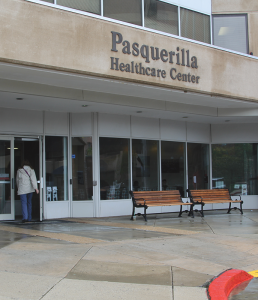
The Transplant Institute’s new outpatient clinic will take up 19,000 square feet in the MedStar Georgetown Pasquerilla Health Center.
The MedStar Georgetown Transplant Institute opened a new $2.4 million outpatient clinic on Tuesday in an attempt to improve the patient experience and consolidate transplant-related care. Backed by corporate and hospital funding from the MedStar Georgetown University Hospital, the new clinic will begin seeing clients Monday.
The 19,000 square foot space, located at the MedStar Georgetown Pasquerilla Healthcare Center, consists of 17 new outpatient rooms for kidney, small bowel, liver, multivisceral and pediatric patients, an upgrade from the previous 11,500 square-foot space with six rooms.
“With greater capacity comes greater efficiency,” David Zwerski, assistant vice president of the Transplant Institute, said.
The clinic addresses the ever-growing transplant business and demand for transplants at the MedStar Georgetown Hospital. In an average year, the Institute performs from 300 to 320 transplants and hundreds of other operations.
“We had really outgrown this space,” MedStar Georgetown Transplant Institute Executive Director Thomas Fishbein (MED ’89) said. “We have so many physicians and patients that we literally could not see them in the current space that we’re in.”
The new design places doctors, researchers and other health professionals closer to the patients, streamlining the multi-step bureaucracy of transplant-related care and allowing the clinic to attend to the physical and emotional needs of the patients.
“It facilitates single encounter care,” Fishbein said. “It is an evolution toward patient-centered care, rather than doctor-centered care. It was very convenient for the doctors in the old-fashioned way, but now it is very focused around the patient experience.”
In addition to creating a more efficient patient experience, the clinic also aims to improve the emotional experience of the patient, for example by facilitating interactions between patients and social workers.
“Patient experience translates to high quality of care and a welcoming environment,” Zwerski said. “We have to make the best of their experience and be receptive to patients, because we know that they’re not always going to get good news.”
Georgetown University Hospital spokesperson Marianne Worley also pointed to the design of the waiting room, which includes paintings and a screen showing educational videos for patients and families to learn more about their condition, as an example of the patient-centric nature of the clinic.
“The theme is rebirth, like the cherry blossoms, spring and the water, because a lot of people feel like when they have a new organ they have a rebirth,” Worley said. “These things are all really important to them. It doesn’t have to feel like a doctor’s office.”
The Medical Center founded the Center for Translational Transplant Medicine in March 2013, which merged with the transplant research already being conducted at the University. Fishbein is the center’s co-director.
“We have 30 to 40 clinical trials open at any given time for patients who are being treated in the transplant institute,” Fishbein said.
By adding space for the center to operate in the clinic itself, researchers can now work among doctors and patients, creating parallels between clinical trials and actual patient work.
“The interdisciplinary element of the clinic will allow us to see patients and, in parallel, have research opportunities, which is for the betterment of transplantation,” Zwerski said.
Fishbein was optimistic about the impact the clinic would have on the Georgetown community.
“The future of Georgetown medicine is here,” he said.




















